Green Cloud Computing: Addressing E-waste and Environmental Concerns
VerifiedAdded on 2021/04/20
|18
|2946
|217
Project
AI Summary
This project delves into the concept of green cloud computing, examining its role in mitigating e-waste and promoting environmental sustainability. The project begins with a rationale that highlights the increasing generation of e-waste and the high energy consumption of data centers, emphasizing the need for green computing solutions. It poses research questions about how green cloud computing addresses e-waste, the steps required for implementation, and its advantages. The project outlines a conceptual framework, explaining how green cloud computing utilizes green use, disposal, design, and manufacturing to reduce e-waste and improve resource efficiency. It details the steps for implementing green computing, including energy-efficient data center design, adherence to computer ethics, e-waste recycling, and telecommunication strategies. The methodology section employs the System Development Life Cycle (SDLC) and secondary data analysis to collect information. It addresses ethical considerations such as carefulness, confidentiality, and human subject protection, along with compliance requirements like occupational safety and health. The project includes a project plan with deliverables, a Work Breakdown Structure (WBS), risk analysis, a detailed timeline, and a Gantt chart. The project concludes by analyzing the positive impact of green cloud computing on e-waste reduction and environmental sustainability, proposing its adoption by Australian manufacturing industries to reduce CO2 emissions.
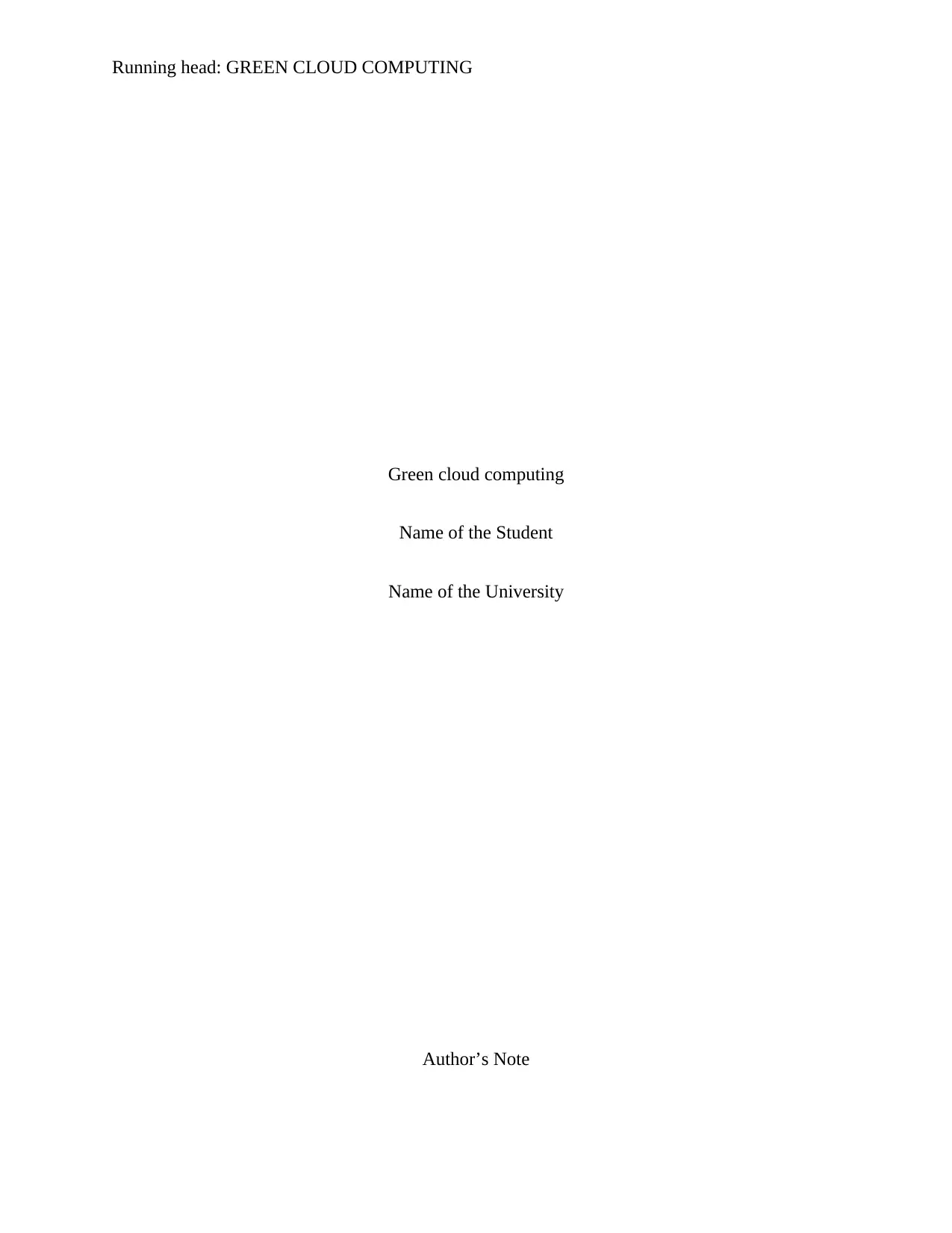
Running head: GREEN CLOUD COMPUTING
Green cloud computing
Name of the Student
Name of the University
Author’s Note
Green cloud computing
Name of the Student
Name of the University
Author’s Note
Paraphrase This Document
Need a fresh take? Get an instant paraphrase of this document with our AI Paraphraser
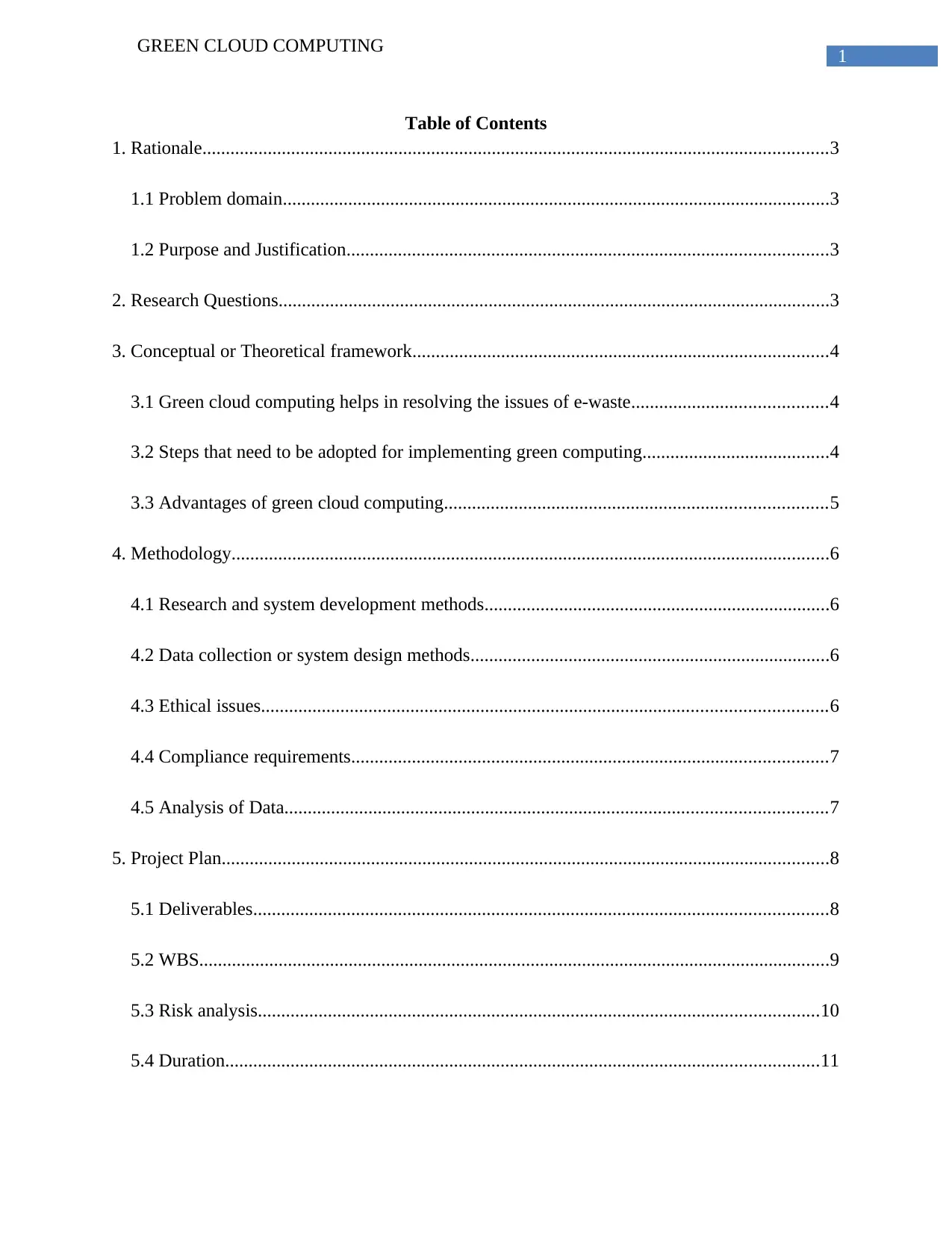
1
GREEN CLOUD COMPUTING
Table of Contents
1. Rationale......................................................................................................................................3
1.1 Problem domain.....................................................................................................................3
1.2 Purpose and Justification.......................................................................................................3
2. Research Questions......................................................................................................................3
3. Conceptual or Theoretical framework.........................................................................................4
3.1 Green cloud computing helps in resolving the issues of e-waste..........................................4
3.2 Steps that need to be adopted for implementing green computing........................................4
3.3 Advantages of green cloud computing..................................................................................5
4. Methodology................................................................................................................................6
4.1 Research and system development methods..........................................................................6
4.2 Data collection or system design methods.............................................................................6
4.3 Ethical issues.........................................................................................................................6
4.4 Compliance requirements......................................................................................................7
4.5 Analysis of Data....................................................................................................................7
5. Project Plan..................................................................................................................................8
5.1 Deliverables...........................................................................................................................8
5.2 WBS.......................................................................................................................................9
5.3 Risk analysis........................................................................................................................10
5.4 Duration...............................................................................................................................11
GREEN CLOUD COMPUTING
Table of Contents
1. Rationale......................................................................................................................................3
1.1 Problem domain.....................................................................................................................3
1.2 Purpose and Justification.......................................................................................................3
2. Research Questions......................................................................................................................3
3. Conceptual or Theoretical framework.........................................................................................4
3.1 Green cloud computing helps in resolving the issues of e-waste..........................................4
3.2 Steps that need to be adopted for implementing green computing........................................4
3.3 Advantages of green cloud computing..................................................................................5
4. Methodology................................................................................................................................6
4.1 Research and system development methods..........................................................................6
4.2 Data collection or system design methods.............................................................................6
4.3 Ethical issues.........................................................................................................................6
4.4 Compliance requirements......................................................................................................7
4.5 Analysis of Data....................................................................................................................7
5. Project Plan..................................................................................................................................8
5.1 Deliverables...........................................................................................................................8
5.2 WBS.......................................................................................................................................9
5.3 Risk analysis........................................................................................................................10
5.4 Duration...............................................................................................................................11

2
GREEN CLOUD COMPUTING
5.5 Gantt chart...........................................................................................................................15
References......................................................................................................................................16
GREEN CLOUD COMPUTING
5.5 Gantt chart...........................................................................................................................15
References......................................................................................................................................16
⊘ This is a preview!⊘
Do you want full access?
Subscribe today to unlock all pages.

Trusted by 1+ million students worldwide
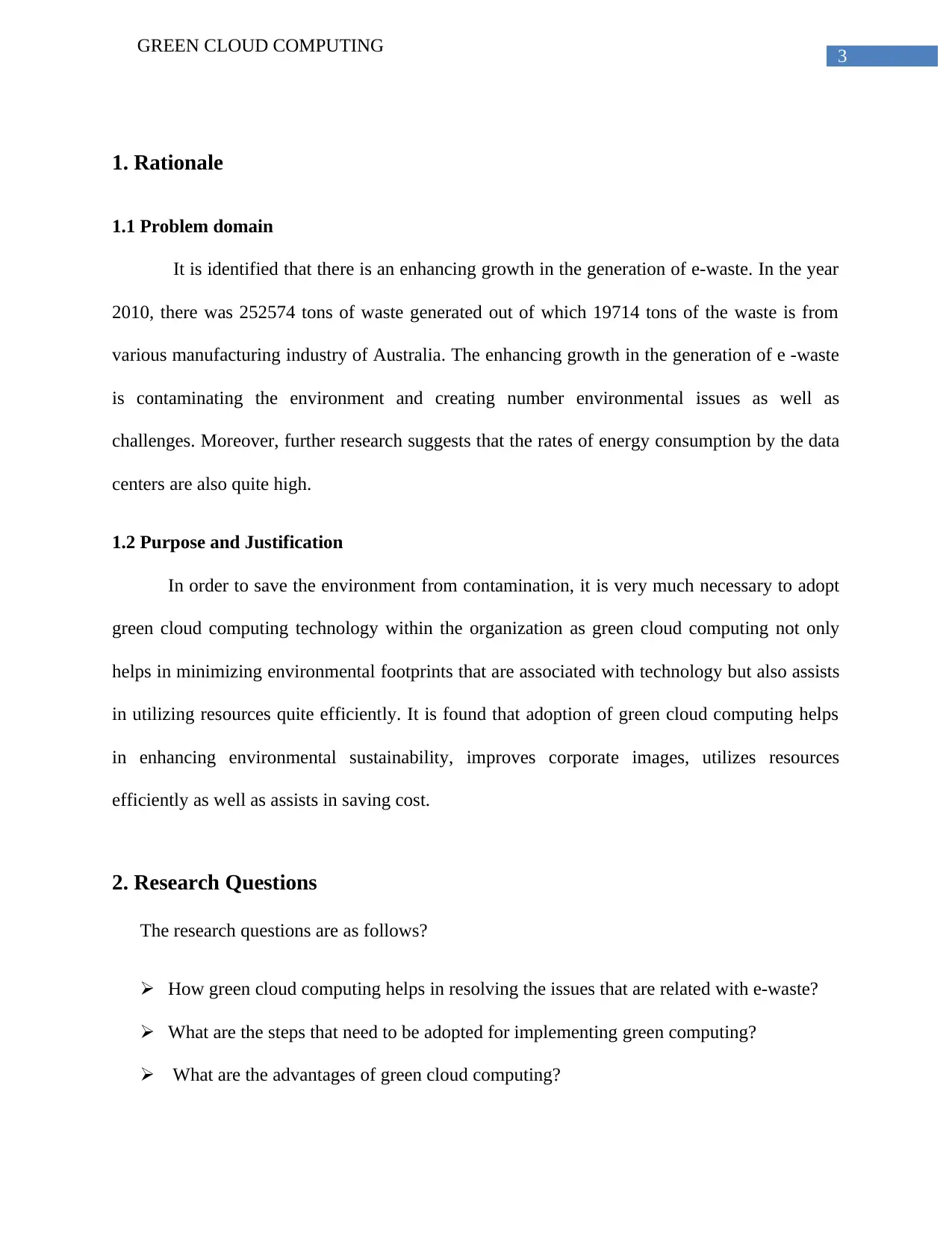
3
GREEN CLOUD COMPUTING
1. Rationale
1.1 Problem domain
It is identified that there is an enhancing growth in the generation of e-waste. In the year
2010, there was 252574 tons of waste generated out of which 19714 tons of the waste is from
various manufacturing industry of Australia. The enhancing growth in the generation of e -waste
is contaminating the environment and creating number environmental issues as well as
challenges. Moreover, further research suggests that the rates of energy consumption by the data
centers are also quite high.
1.2 Purpose and Justification
In order to save the environment from contamination, it is very much necessary to adopt
green cloud computing technology within the organization as green cloud computing not only
helps in minimizing environmental footprints that are associated with technology but also assists
in utilizing resources quite efficiently. It is found that adoption of green cloud computing helps
in enhancing environmental sustainability, improves corporate images, utilizes resources
efficiently as well as assists in saving cost.
2. Research Questions
The research questions are as follows?
How green cloud computing helps in resolving the issues that are related with e-waste?
What are the steps that need to be adopted for implementing green computing?
What are the advantages of green cloud computing?
GREEN CLOUD COMPUTING
1. Rationale
1.1 Problem domain
It is identified that there is an enhancing growth in the generation of e-waste. In the year
2010, there was 252574 tons of waste generated out of which 19714 tons of the waste is from
various manufacturing industry of Australia. The enhancing growth in the generation of e -waste
is contaminating the environment and creating number environmental issues as well as
challenges. Moreover, further research suggests that the rates of energy consumption by the data
centers are also quite high.
1.2 Purpose and Justification
In order to save the environment from contamination, it is very much necessary to adopt
green cloud computing technology within the organization as green cloud computing not only
helps in minimizing environmental footprints that are associated with technology but also assists
in utilizing resources quite efficiently. It is found that adoption of green cloud computing helps
in enhancing environmental sustainability, improves corporate images, utilizes resources
efficiently as well as assists in saving cost.
2. Research Questions
The research questions are as follows?
How green cloud computing helps in resolving the issues that are related with e-waste?
What are the steps that need to be adopted for implementing green computing?
What are the advantages of green cloud computing?
Paraphrase This Document
Need a fresh take? Get an instant paraphrase of this document with our AI Paraphraser
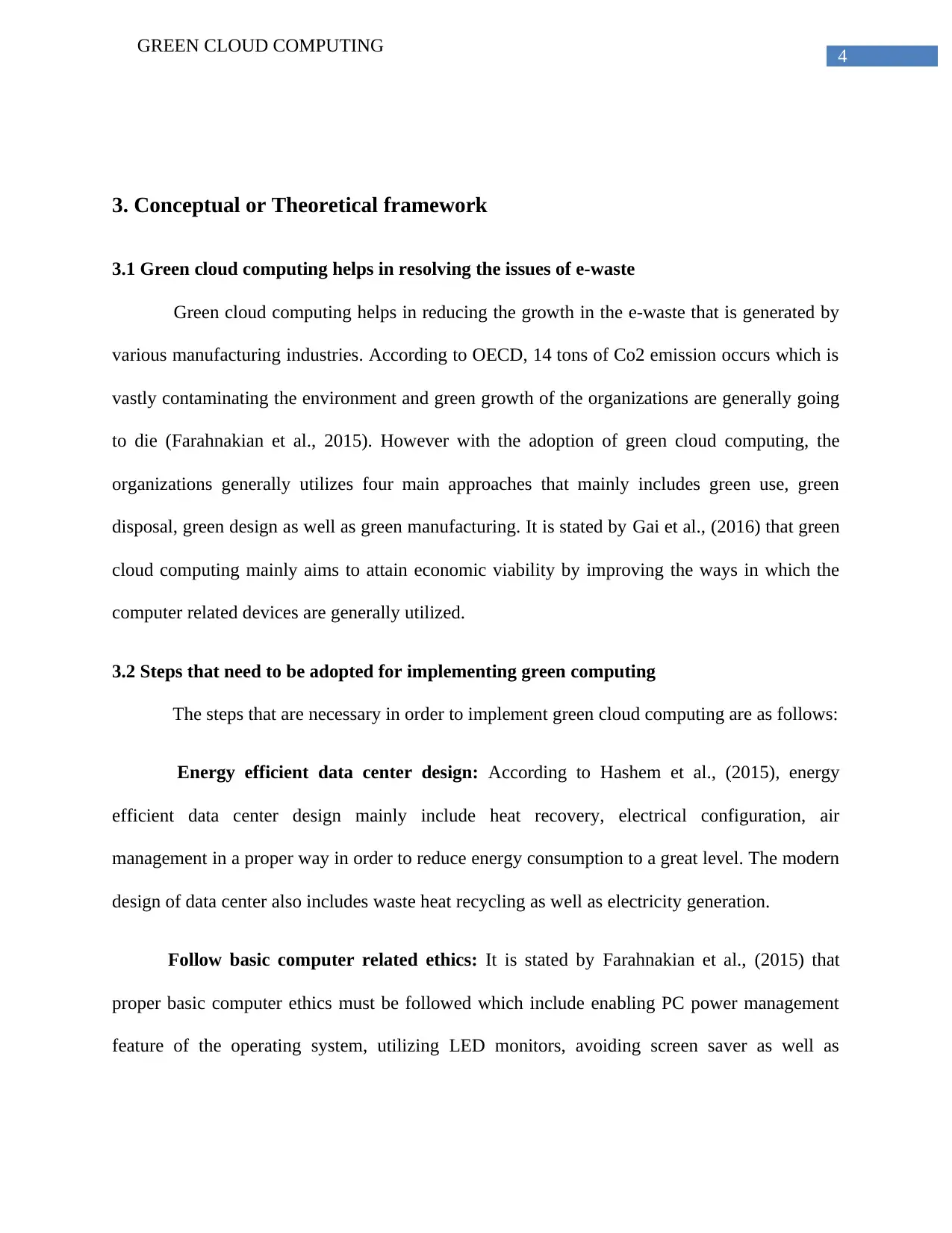
4
GREEN CLOUD COMPUTING
3. Conceptual or Theoretical framework
3.1 Green cloud computing helps in resolving the issues of e-waste
Green cloud computing helps in reducing the growth in the e-waste that is generated by
various manufacturing industries. According to OECD, 14 tons of Co2 emission occurs which is
vastly contaminating the environment and green growth of the organizations are generally going
to die (Farahnakian et al., 2015). However with the adoption of green cloud computing, the
organizations generally utilizes four main approaches that mainly includes green use, green
disposal, green design as well as green manufacturing. It is stated by Gai et al., (2016) that green
cloud computing mainly aims to attain economic viability by improving the ways in which the
computer related devices are generally utilized.
3.2 Steps that need to be adopted for implementing green computing
The steps that are necessary in order to implement green cloud computing are as follows:
Energy efficient data center design: According to Hashem et al., (2015), energy
efficient data center design mainly include heat recovery, electrical configuration, air
management in a proper way in order to reduce energy consumption to a great level. The modern
design of data center also includes waste heat recycling as well as electricity generation.
Follow basic computer related ethics: It is stated by Farahnakian et al., (2015) that
proper basic computer ethics must be followed which include enabling PC power management
feature of the operating system, utilizing LED monitors, avoiding screen saver as well as
GREEN CLOUD COMPUTING
3. Conceptual or Theoretical framework
3.1 Green cloud computing helps in resolving the issues of e-waste
Green cloud computing helps in reducing the growth in the e-waste that is generated by
various manufacturing industries. According to OECD, 14 tons of Co2 emission occurs which is
vastly contaminating the environment and green growth of the organizations are generally going
to die (Farahnakian et al., 2015). However with the adoption of green cloud computing, the
organizations generally utilizes four main approaches that mainly includes green use, green
disposal, green design as well as green manufacturing. It is stated by Gai et al., (2016) that green
cloud computing mainly aims to attain economic viability by improving the ways in which the
computer related devices are generally utilized.
3.2 Steps that need to be adopted for implementing green computing
The steps that are necessary in order to implement green cloud computing are as follows:
Energy efficient data center design: According to Hashem et al., (2015), energy
efficient data center design mainly include heat recovery, electrical configuration, air
management in a proper way in order to reduce energy consumption to a great level. The modern
design of data center also includes waste heat recycling as well as electricity generation.
Follow basic computer related ethics: It is stated by Farahnakian et al., (2015) that
proper basic computer ethics must be followed which include enabling PC power management
feature of the operating system, utilizing LED monitors, avoiding screen saver as well as
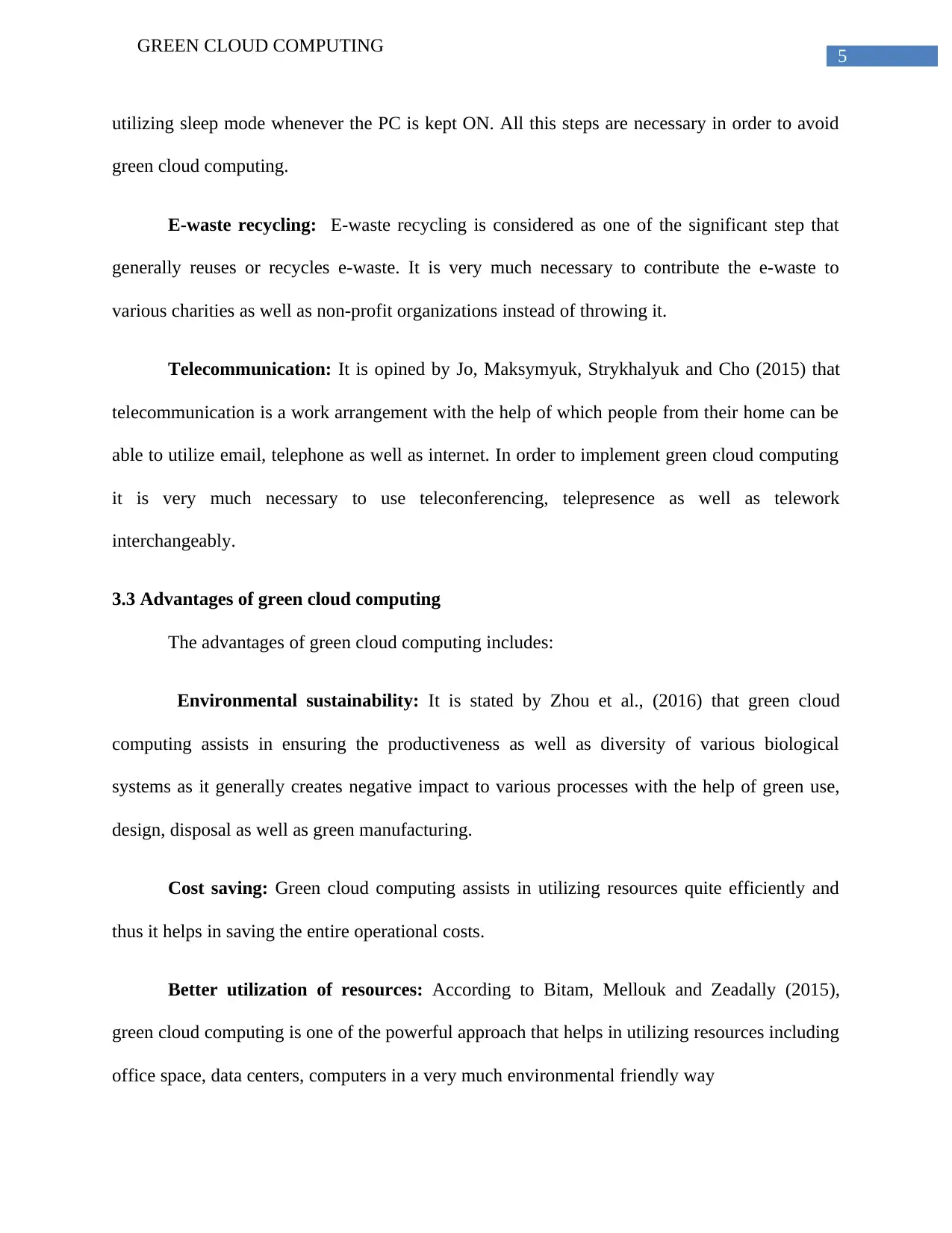
5
GREEN CLOUD COMPUTING
utilizing sleep mode whenever the PC is kept ON. All this steps are necessary in order to avoid
green cloud computing.
E-waste recycling: E-waste recycling is considered as one of the significant step that
generally reuses or recycles e-waste. It is very much necessary to contribute the e-waste to
various charities as well as non-profit organizations instead of throwing it.
Telecommunication: It is opined by Jo, Maksymyuk, Strykhalyuk and Cho (2015) that
telecommunication is a work arrangement with the help of which people from their home can be
able to utilize email, telephone as well as internet. In order to implement green cloud computing
it is very much necessary to use teleconferencing, telepresence as well as telework
interchangeably.
3.3 Advantages of green cloud computing
The advantages of green cloud computing includes:
Environmental sustainability: It is stated by Zhou et al., (2016) that green cloud
computing assists in ensuring the productiveness as well as diversity of various biological
systems as it generally creates negative impact to various processes with the help of green use,
design, disposal as well as green manufacturing.
Cost saving: Green cloud computing assists in utilizing resources quite efficiently and
thus it helps in saving the entire operational costs.
Better utilization of resources: According to Bitam, Mellouk and Zeadally (2015),
green cloud computing is one of the powerful approach that helps in utilizing resources including
office space, data centers, computers in a very much environmental friendly way
GREEN CLOUD COMPUTING
utilizing sleep mode whenever the PC is kept ON. All this steps are necessary in order to avoid
green cloud computing.
E-waste recycling: E-waste recycling is considered as one of the significant step that
generally reuses or recycles e-waste. It is very much necessary to contribute the e-waste to
various charities as well as non-profit organizations instead of throwing it.
Telecommunication: It is opined by Jo, Maksymyuk, Strykhalyuk and Cho (2015) that
telecommunication is a work arrangement with the help of which people from their home can be
able to utilize email, telephone as well as internet. In order to implement green cloud computing
it is very much necessary to use teleconferencing, telepresence as well as telework
interchangeably.
3.3 Advantages of green cloud computing
The advantages of green cloud computing includes:
Environmental sustainability: It is stated by Zhou et al., (2016) that green cloud
computing assists in ensuring the productiveness as well as diversity of various biological
systems as it generally creates negative impact to various processes with the help of green use,
design, disposal as well as green manufacturing.
Cost saving: Green cloud computing assists in utilizing resources quite efficiently and
thus it helps in saving the entire operational costs.
Better utilization of resources: According to Bitam, Mellouk and Zeadally (2015),
green cloud computing is one of the powerful approach that helps in utilizing resources including
office space, data centers, computers in a very much environmental friendly way
⊘ This is a preview!⊘
Do you want full access?
Subscribe today to unlock all pages.

Trusted by 1+ million students worldwide
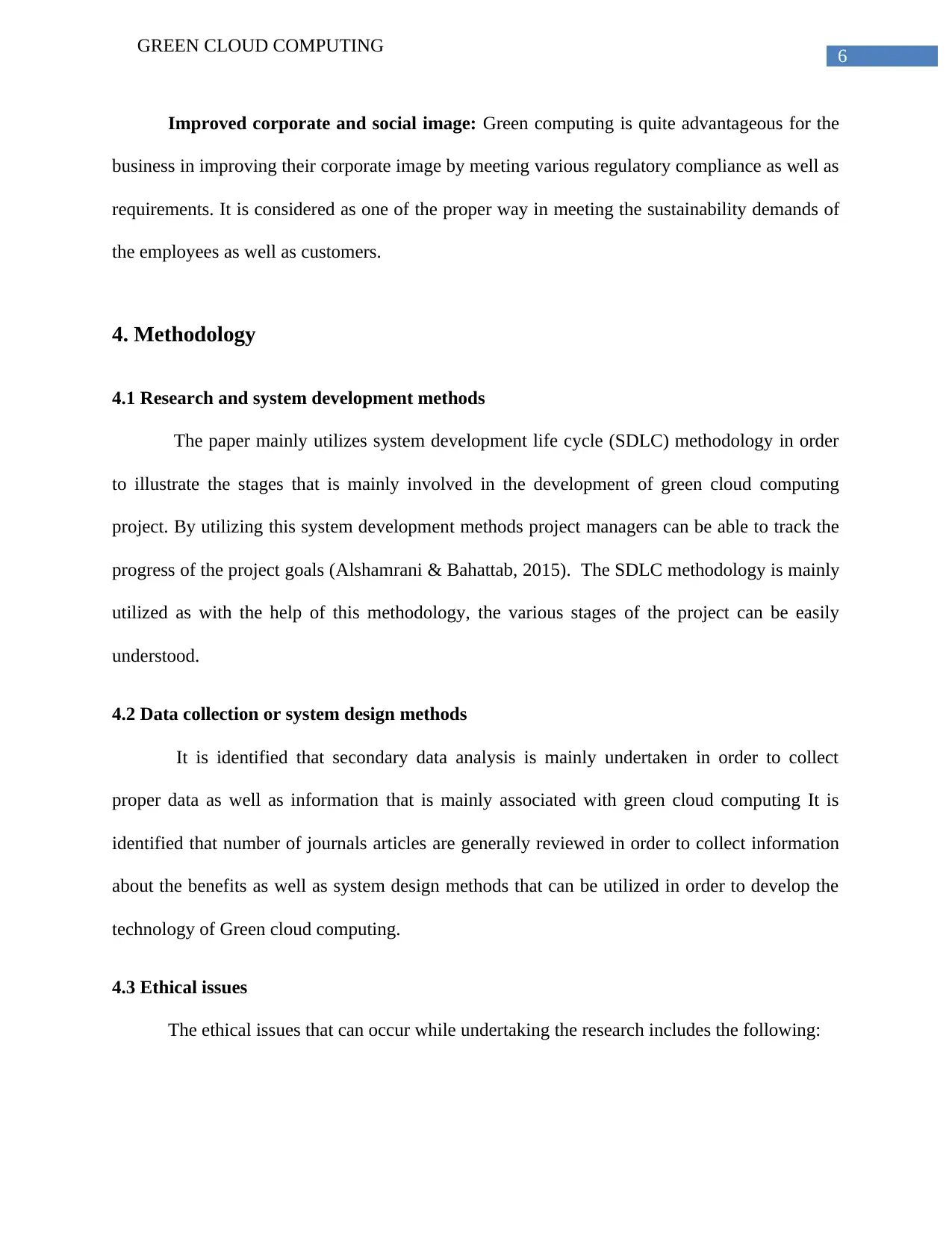
6
GREEN CLOUD COMPUTING
Improved corporate and social image: Green computing is quite advantageous for the
business in improving their corporate image by meeting various regulatory compliance as well as
requirements. It is considered as one of the proper way in meeting the sustainability demands of
the employees as well as customers.
4. Methodology
4.1 Research and system development methods
The paper mainly utilizes system development life cycle (SDLC) methodology in order
to illustrate the stages that is mainly involved in the development of green cloud computing
project. By utilizing this system development methods project managers can be able to track the
progress of the project goals (Alshamrani & Bahattab, 2015). The SDLC methodology is mainly
utilized as with the help of this methodology, the various stages of the project can be easily
understood.
4.2 Data collection or system design methods
It is identified that secondary data analysis is mainly undertaken in order to collect
proper data as well as information that is mainly associated with green cloud computing It is
identified that number of journals articles are generally reviewed in order to collect information
about the benefits as well as system design methods that can be utilized in order to develop the
technology of Green cloud computing.
4.3 Ethical issues
The ethical issues that can occur while undertaking the research includes the following:
GREEN CLOUD COMPUTING
Improved corporate and social image: Green computing is quite advantageous for the
business in improving their corporate image by meeting various regulatory compliance as well as
requirements. It is considered as one of the proper way in meeting the sustainability demands of
the employees as well as customers.
4. Methodology
4.1 Research and system development methods
The paper mainly utilizes system development life cycle (SDLC) methodology in order
to illustrate the stages that is mainly involved in the development of green cloud computing
project. By utilizing this system development methods project managers can be able to track the
progress of the project goals (Alshamrani & Bahattab, 2015). The SDLC methodology is mainly
utilized as with the help of this methodology, the various stages of the project can be easily
understood.
4.2 Data collection or system design methods
It is identified that secondary data analysis is mainly undertaken in order to collect
proper data as well as information that is mainly associated with green cloud computing It is
identified that number of journals articles are generally reviewed in order to collect information
about the benefits as well as system design methods that can be utilized in order to develop the
technology of Green cloud computing.
4.3 Ethical issues
The ethical issues that can occur while undertaking the research includes the following:
Paraphrase This Document
Need a fresh take? Get an instant paraphrase of this document with our AI Paraphraser
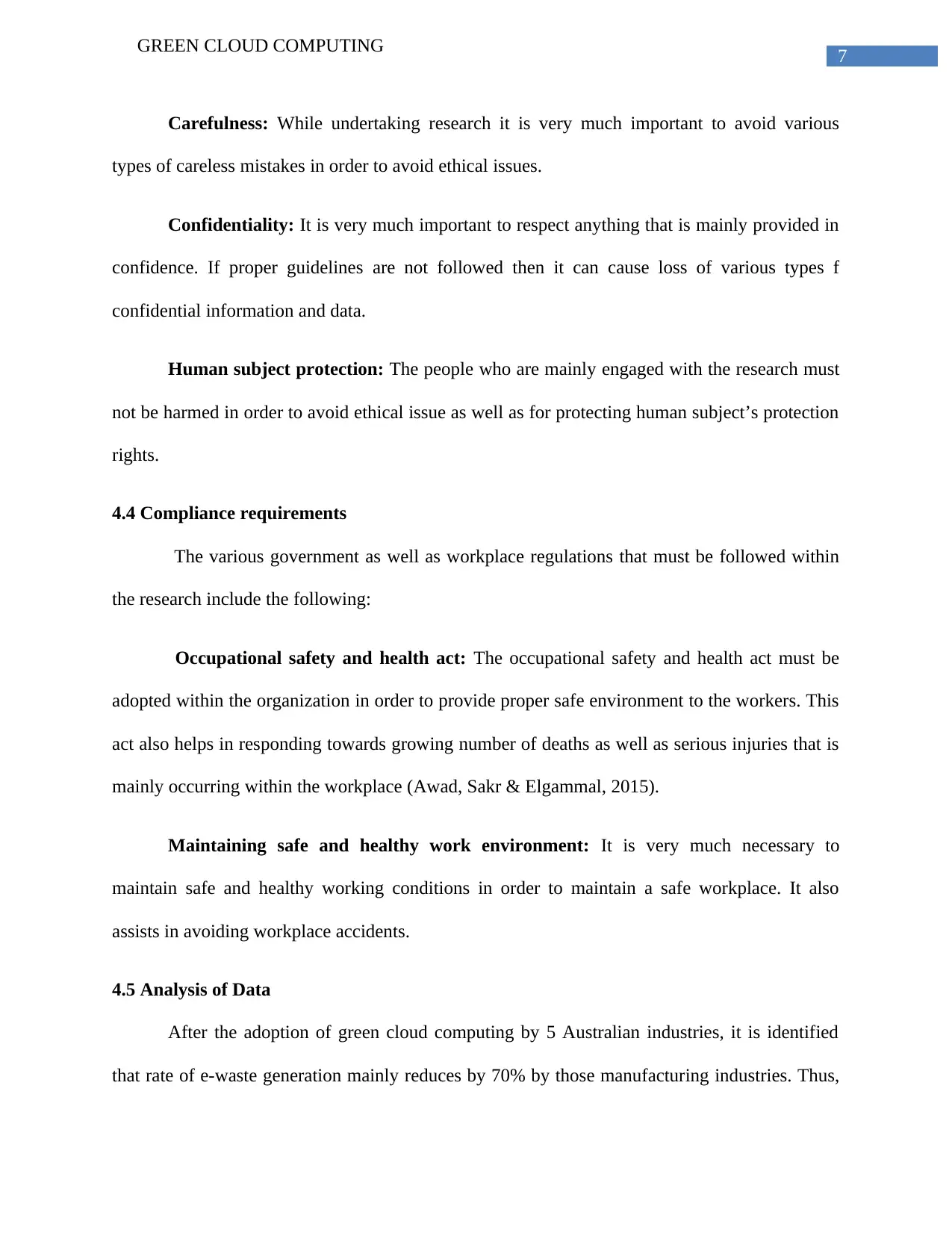
7
GREEN CLOUD COMPUTING
Carefulness: While undertaking research it is very much important to avoid various
types of careless mistakes in order to avoid ethical issues.
Confidentiality: It is very much important to respect anything that is mainly provided in
confidence. If proper guidelines are not followed then it can cause loss of various types f
confidential information and data.
Human subject protection: The people who are mainly engaged with the research must
not be harmed in order to avoid ethical issue as well as for protecting human subject’s protection
rights.
4.4 Compliance requirements
The various government as well as workplace regulations that must be followed within
the research include the following:
Occupational safety and health act: The occupational safety and health act must be
adopted within the organization in order to provide proper safe environment to the workers. This
act also helps in responding towards growing number of deaths as well as serious injuries that is
mainly occurring within the workplace (Awad, Sakr & Elgammal, 2015).
Maintaining safe and healthy work environment: It is very much necessary to
maintain safe and healthy working conditions in order to maintain a safe workplace. It also
assists in avoiding workplace accidents.
4.5 Analysis of Data
After the adoption of green cloud computing by 5 Australian industries, it is identified
that rate of e-waste generation mainly reduces by 70% by those manufacturing industries. Thus,
GREEN CLOUD COMPUTING
Carefulness: While undertaking research it is very much important to avoid various
types of careless mistakes in order to avoid ethical issues.
Confidentiality: It is very much important to respect anything that is mainly provided in
confidence. If proper guidelines are not followed then it can cause loss of various types f
confidential information and data.
Human subject protection: The people who are mainly engaged with the research must
not be harmed in order to avoid ethical issue as well as for protecting human subject’s protection
rights.
4.4 Compliance requirements
The various government as well as workplace regulations that must be followed within
the research include the following:
Occupational safety and health act: The occupational safety and health act must be
adopted within the organization in order to provide proper safe environment to the workers. This
act also helps in responding towards growing number of deaths as well as serious injuries that is
mainly occurring within the workplace (Awad, Sakr & Elgammal, 2015).
Maintaining safe and healthy work environment: It is very much necessary to
maintain safe and healthy working conditions in order to maintain a safe workplace. It also
assists in avoiding workplace accidents.
4.5 Analysis of Data
After the adoption of green cloud computing by 5 Australian industries, it is identified
that rate of e-waste generation mainly reduces by 70% by those manufacturing industries. Thus,
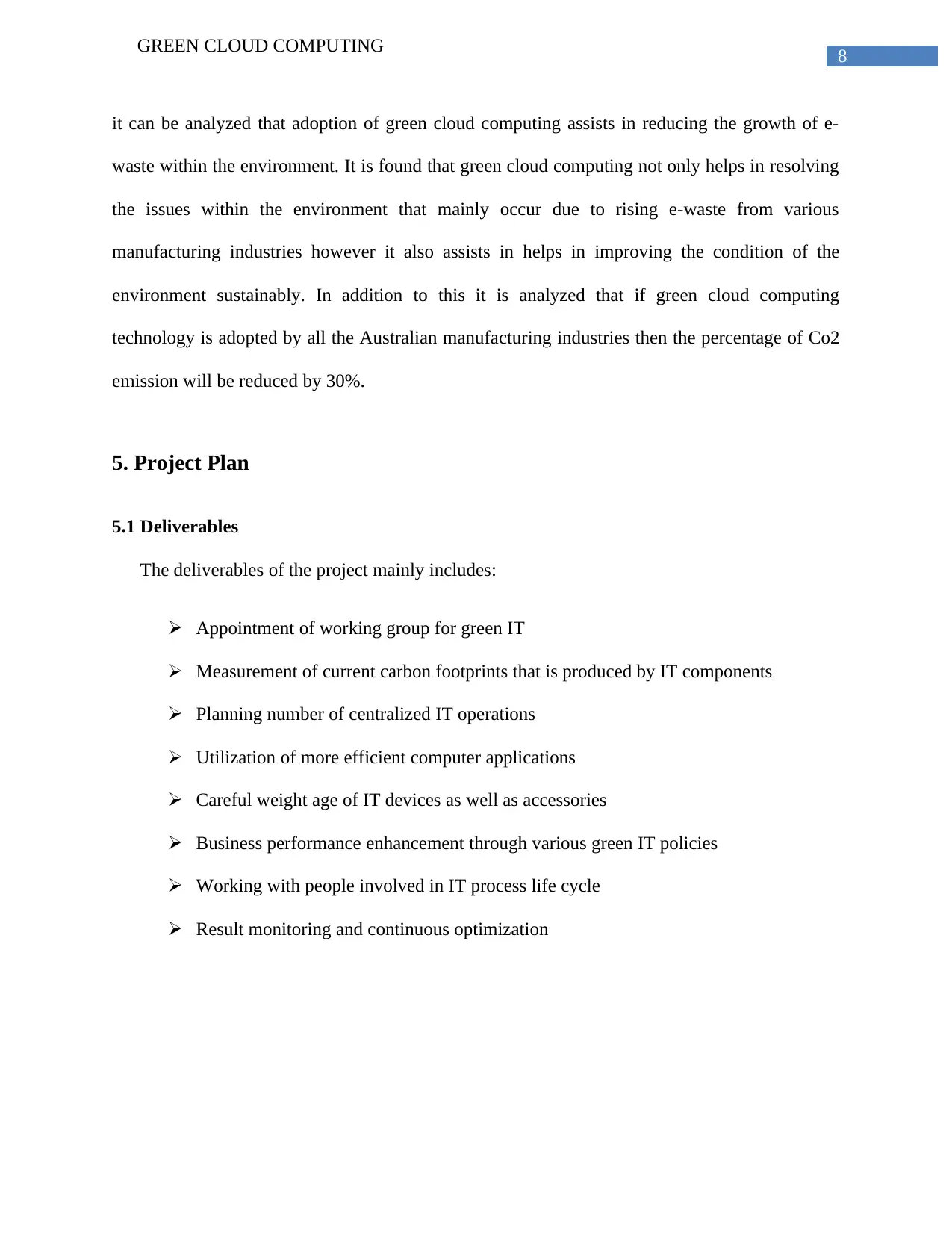
8
GREEN CLOUD COMPUTING
it can be analyzed that adoption of green cloud computing assists in reducing the growth of e-
waste within the environment. It is found that green cloud computing not only helps in resolving
the issues within the environment that mainly occur due to rising e-waste from various
manufacturing industries however it also assists in helps in improving the condition of the
environment sustainably. In addition to this it is analyzed that if green cloud computing
technology is adopted by all the Australian manufacturing industries then the percentage of Co2
emission will be reduced by 30%.
5. Project Plan
5.1 Deliverables
The deliverables of the project mainly includes:
Appointment of working group for green IT
Measurement of current carbon footprints that is produced by IT components
Planning number of centralized IT operations
Utilization of more efficient computer applications
Careful weight age of IT devices as well as accessories
Business performance enhancement through various green IT policies
Working with people involved in IT process life cycle
Result monitoring and continuous optimization
GREEN CLOUD COMPUTING
it can be analyzed that adoption of green cloud computing assists in reducing the growth of e-
waste within the environment. It is found that green cloud computing not only helps in resolving
the issues within the environment that mainly occur due to rising e-waste from various
manufacturing industries however it also assists in helps in improving the condition of the
environment sustainably. In addition to this it is analyzed that if green cloud computing
technology is adopted by all the Australian manufacturing industries then the percentage of Co2
emission will be reduced by 30%.
5. Project Plan
5.1 Deliverables
The deliverables of the project mainly includes:
Appointment of working group for green IT
Measurement of current carbon footprints that is produced by IT components
Planning number of centralized IT operations
Utilization of more efficient computer applications
Careful weight age of IT devices as well as accessories
Business performance enhancement through various green IT policies
Working with people involved in IT process life cycle
Result monitoring and continuous optimization
⊘ This is a preview!⊘
Do you want full access?
Subscribe today to unlock all pages.

Trusted by 1+ million students worldwide
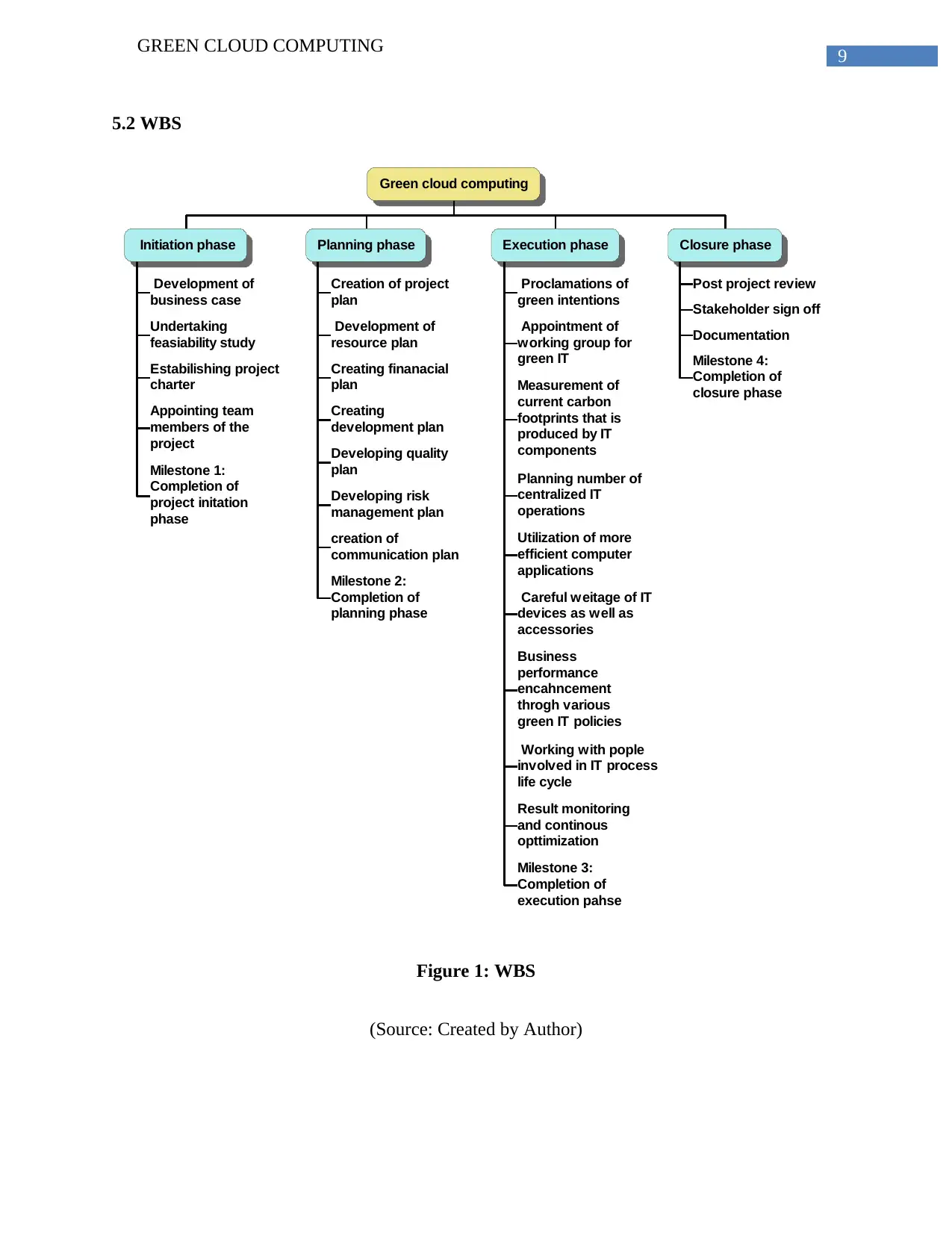
9
GREEN CLOUD COMPUTING
5.2 WBS
Green cloud computing
Initiation phase
Development of
business case
Undertaking
feasiability study
Estabilishing project
charter
Appointing team
members of the
project
Milestone 1:
Completion of
project initation
phase
Planning phase
Creation of project
plan
Development of
resource plan
Creating finanacial
plan
Creating
development plan
Developing quality
plan
Developing risk
management plan
creation of
communication plan
Milestone 2:
Completion of
planning phase
Execution phase
Proclamations of
green intentions
Appointment of
working group for
green IT
Measurement of
current carbon
footprints that is
produced by IT
components
Planning number of
centralized IT
operations
Utilization of more
efficient computer
applications
Careful weitage of IT
devices as well as
accessories
Business
performance
encahncement
throgh various
green IT policies
Working with pople
involved in IT process
life cycle
Result monitoring
and continous
opttimization
Milestone 3:
Completion of
execution pahse
Closure phase
Post project review
Stakeholder sign off
Documentation
Milestone 4:
Completion of
closure phase
Figure 1: WBS
(Source: Created by Author)
GREEN CLOUD COMPUTING
5.2 WBS
Green cloud computing
Initiation phase
Development of
business case
Undertaking
feasiability study
Estabilishing project
charter
Appointing team
members of the
project
Milestone 1:
Completion of
project initation
phase
Planning phase
Creation of project
plan
Development of
resource plan
Creating finanacial
plan
Creating
development plan
Developing quality
plan
Developing risk
management plan
creation of
communication plan
Milestone 2:
Completion of
planning phase
Execution phase
Proclamations of
green intentions
Appointment of
working group for
green IT
Measurement of
current carbon
footprints that is
produced by IT
components
Planning number of
centralized IT
operations
Utilization of more
efficient computer
applications
Careful weitage of IT
devices as well as
accessories
Business
performance
encahncement
throgh various
green IT policies
Working with pople
involved in IT process
life cycle
Result monitoring
and continous
opttimization
Milestone 3:
Completion of
execution pahse
Closure phase
Post project review
Stakeholder sign off
Documentation
Milestone 4:
Completion of
closure phase
Figure 1: WBS
(Source: Created by Author)
Paraphrase This Document
Need a fresh take? Get an instant paraphrase of this document with our AI Paraphraser
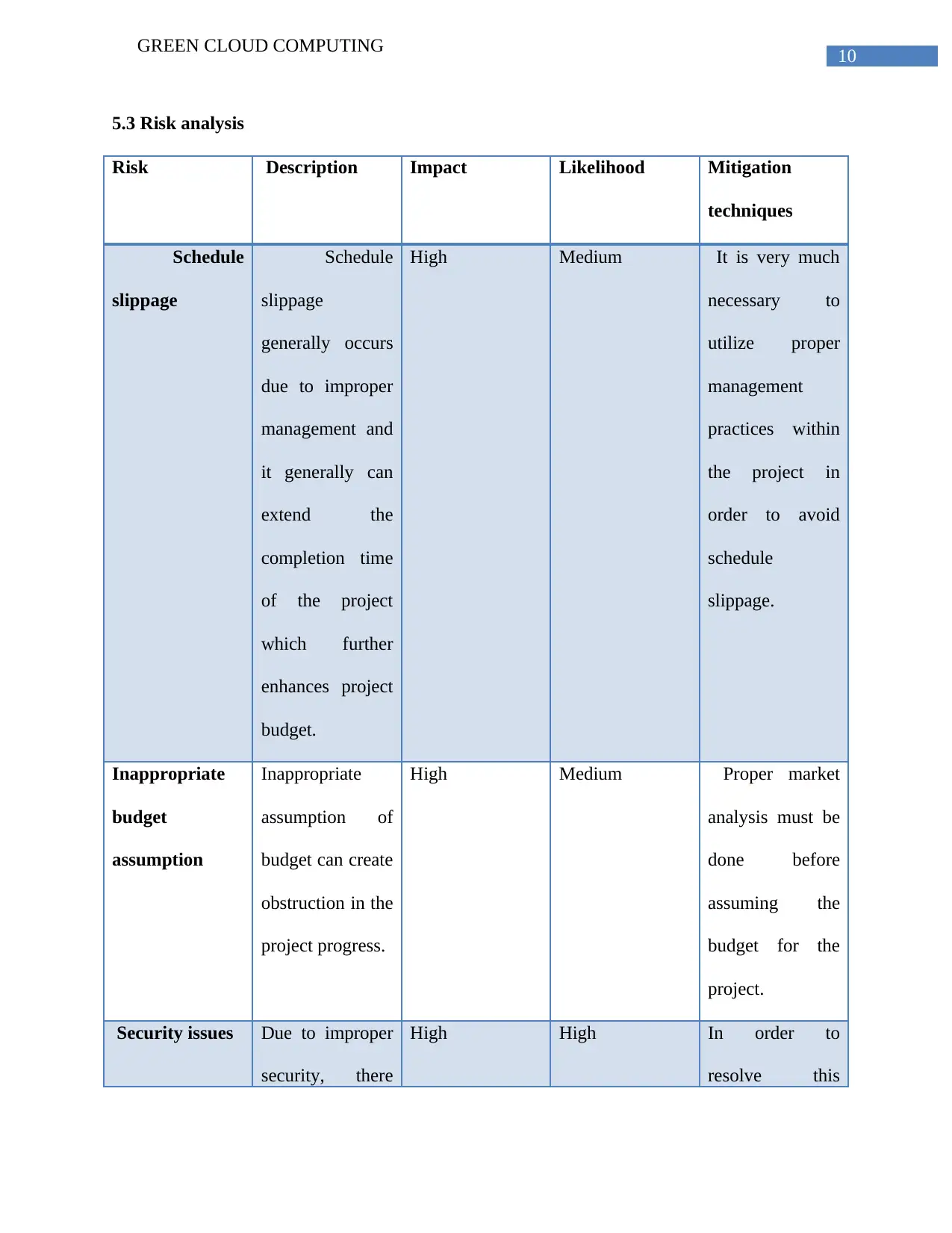
10
GREEN CLOUD COMPUTING
5.3 Risk analysis
Risk Description Impact Likelihood Mitigation
techniques
Schedule
slippage
Schedule
slippage
generally occurs
due to improper
management and
it generally can
extend the
completion time
of the project
which further
enhances project
budget.
High Medium It is very much
necessary to
utilize proper
management
practices within
the project in
order to avoid
schedule
slippage.
Inappropriate
budget
assumption
Inappropriate
assumption of
budget can create
obstruction in the
project progress.
High Medium Proper market
analysis must be
done before
assuming the
budget for the
project.
Security issues Due to improper
security, there
High High In order to
resolve this
GREEN CLOUD COMPUTING
5.3 Risk analysis
Risk Description Impact Likelihood Mitigation
techniques
Schedule
slippage
Schedule
slippage
generally occurs
due to improper
management and
it generally can
extend the
completion time
of the project
which further
enhances project
budget.
High Medium It is very much
necessary to
utilize proper
management
practices within
the project in
order to avoid
schedule
slippage.
Inappropriate
budget
assumption
Inappropriate
assumption of
budget can create
obstruction in the
project progress.
High Medium Proper market
analysis must be
done before
assuming the
budget for the
project.
Security issues Due to improper
security, there
High High In order to
resolve this
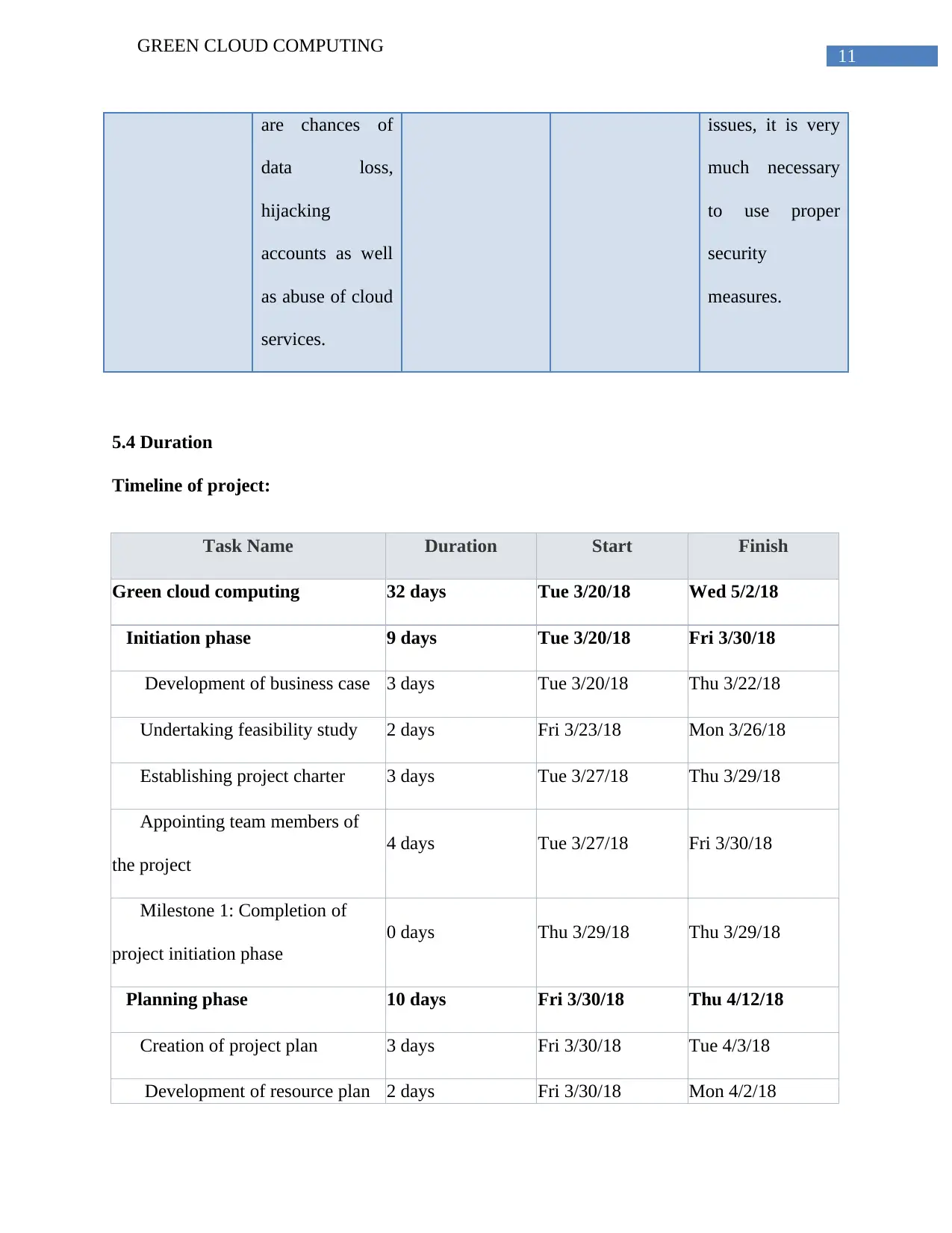
11
GREEN CLOUD COMPUTING
are chances of
data loss,
hijacking
accounts as well
as abuse of cloud
services.
issues, it is very
much necessary
to use proper
security
measures.
5.4 Duration
Timeline of project:
Task Name Duration Start Finish
Green cloud computing 32 days Tue 3/20/18 Wed 5/2/18
Initiation phase 9 days Tue 3/20/18 Fri 3/30/18
Development of business case 3 days Tue 3/20/18 Thu 3/22/18
Undertaking feasibility study 2 days Fri 3/23/18 Mon 3/26/18
Establishing project charter 3 days Tue 3/27/18 Thu 3/29/18
Appointing team members of
the project
4 days Tue 3/27/18 Fri 3/30/18
Milestone 1: Completion of
project initiation phase
0 days Thu 3/29/18 Thu 3/29/18
Planning phase 10 days Fri 3/30/18 Thu 4/12/18
Creation of project plan 3 days Fri 3/30/18 Tue 4/3/18
Development of resource plan 2 days Fri 3/30/18 Mon 4/2/18
GREEN CLOUD COMPUTING
are chances of
data loss,
hijacking
accounts as well
as abuse of cloud
services.
issues, it is very
much necessary
to use proper
security
measures.
5.4 Duration
Timeline of project:
Task Name Duration Start Finish
Green cloud computing 32 days Tue 3/20/18 Wed 5/2/18
Initiation phase 9 days Tue 3/20/18 Fri 3/30/18
Development of business case 3 days Tue 3/20/18 Thu 3/22/18
Undertaking feasibility study 2 days Fri 3/23/18 Mon 3/26/18
Establishing project charter 3 days Tue 3/27/18 Thu 3/29/18
Appointing team members of
the project
4 days Tue 3/27/18 Fri 3/30/18
Milestone 1: Completion of
project initiation phase
0 days Thu 3/29/18 Thu 3/29/18
Planning phase 10 days Fri 3/30/18 Thu 4/12/18
Creation of project plan 3 days Fri 3/30/18 Tue 4/3/18
Development of resource plan 2 days Fri 3/30/18 Mon 4/2/18
⊘ This is a preview!⊘
Do you want full access?
Subscribe today to unlock all pages.

Trusted by 1+ million students worldwide
1 out of 18
Related Documents
Your All-in-One AI-Powered Toolkit for Academic Success.
+13062052269
info@desklib.com
Available 24*7 on WhatsApp / Email
![[object Object]](/_next/static/media/star-bottom.7253800d.svg)
Unlock your academic potential
Copyright © 2020–2025 A2Z Services. All Rights Reserved. Developed and managed by ZUCOL.




